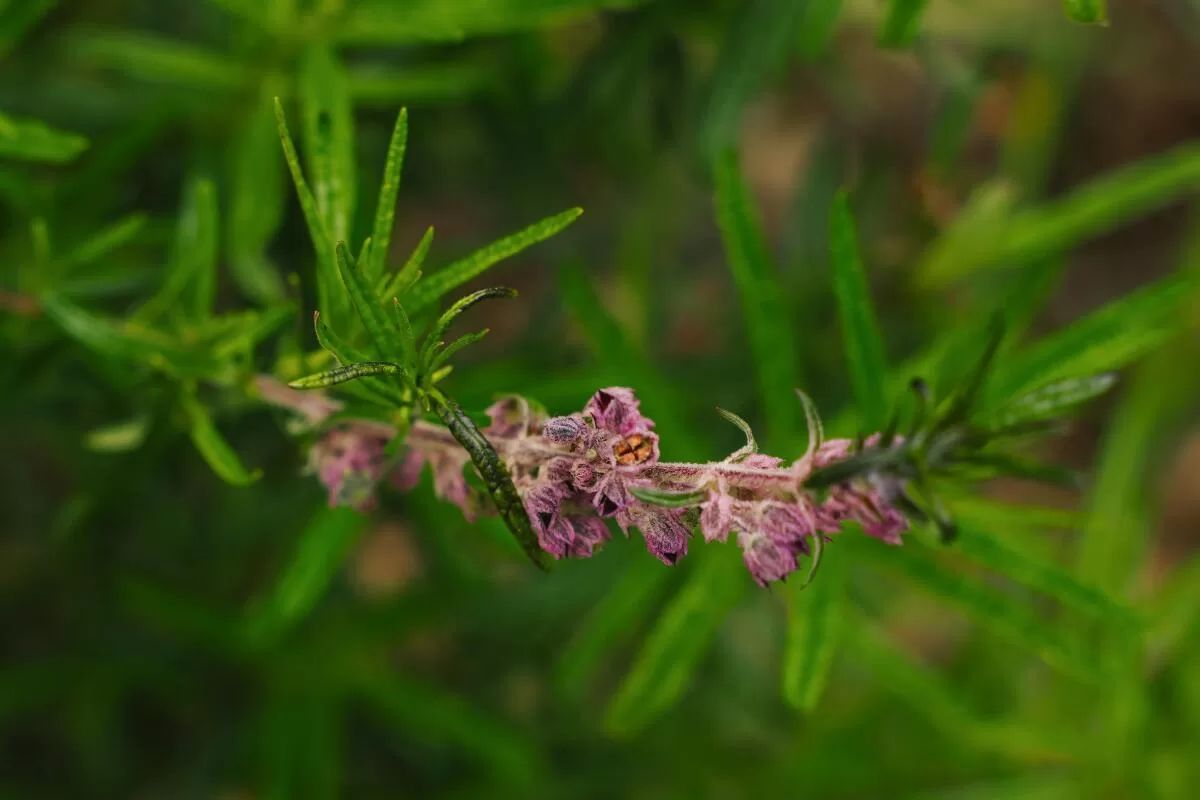Welcome to September, and what feels like our headlong rush to the Nov. 5 election. Are you registered to vote? Because the last day to register in California is Oct. 21, and this is one party you don’t want to miss.
Now that we’re moving into fall and (fingers crossed) cooler weather, it’s time to start thinking about planting again. If you need inspiration for your vegetable garden, Baker Creek Heirloom Seeds is holding its second Rare Seeds National Heirloom Expo in Ventura Sept. 10-12, and there are several other food-growing events listed in the calendar below.
Many of us are also thinking about adding water-saving, habitat-building native plants to our patios and yards, but before you start, it’s time for some tough talk: Native plant landscapes often fail because of our ignorance.
We think, “California native plants should grow easily here, because they’re native, right?” So people buy expensive plants and expect them to grow like weeds (as in anywhere at all without any tending) and the results are often disastrous. Here’s what experts say are the four most common mistakes:
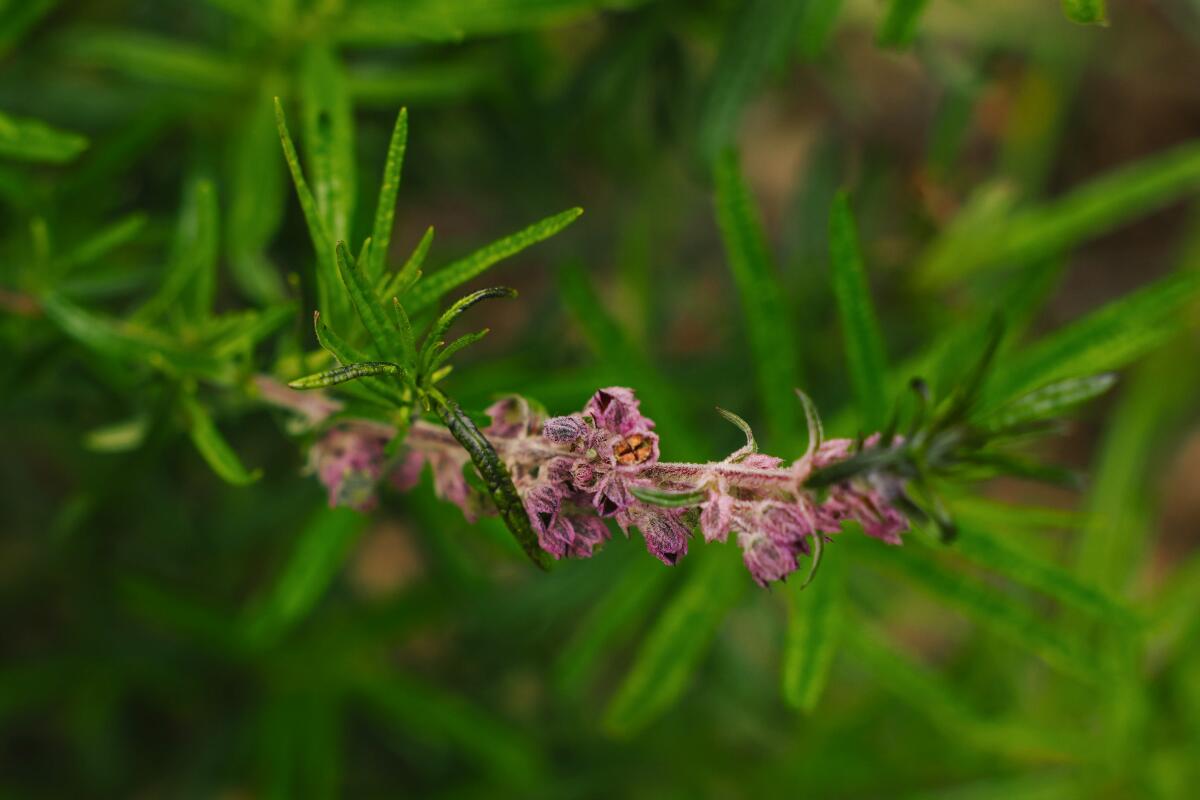
A branch of woolly bluecurls at the California Botanic Garden.
(Dania Maxwell / Los Angeles Times)
Poor placement
How, when and where you put your native plants are critically important to their success. For instance, sticking a fragrant woolly bluecurls (Trichostema lanatum) next to a rose might feel like a pretty choice, but the rose needs far more water than the woolly bluecurls, which tolerates almost no summer water once it’s established.
Grouping plants that like similar conditions means you’ll have a happier garden, said botanist Terry Huang, director of living collections at South Coast Botanic Garden and a regular instructor for the Theodore Payne Foundation’s classes about where and how to plant California native plants.
The best time to plant is the late fall, so the plants can take advantage of winter rains to get established before the dry heat of summer. Mike Evans, founder of the Tree of Life Nursery in San Juan Capistrano, has made several useful explainers on the website, including a short, step-by-step video explaining how to plant native trees and shrubs.
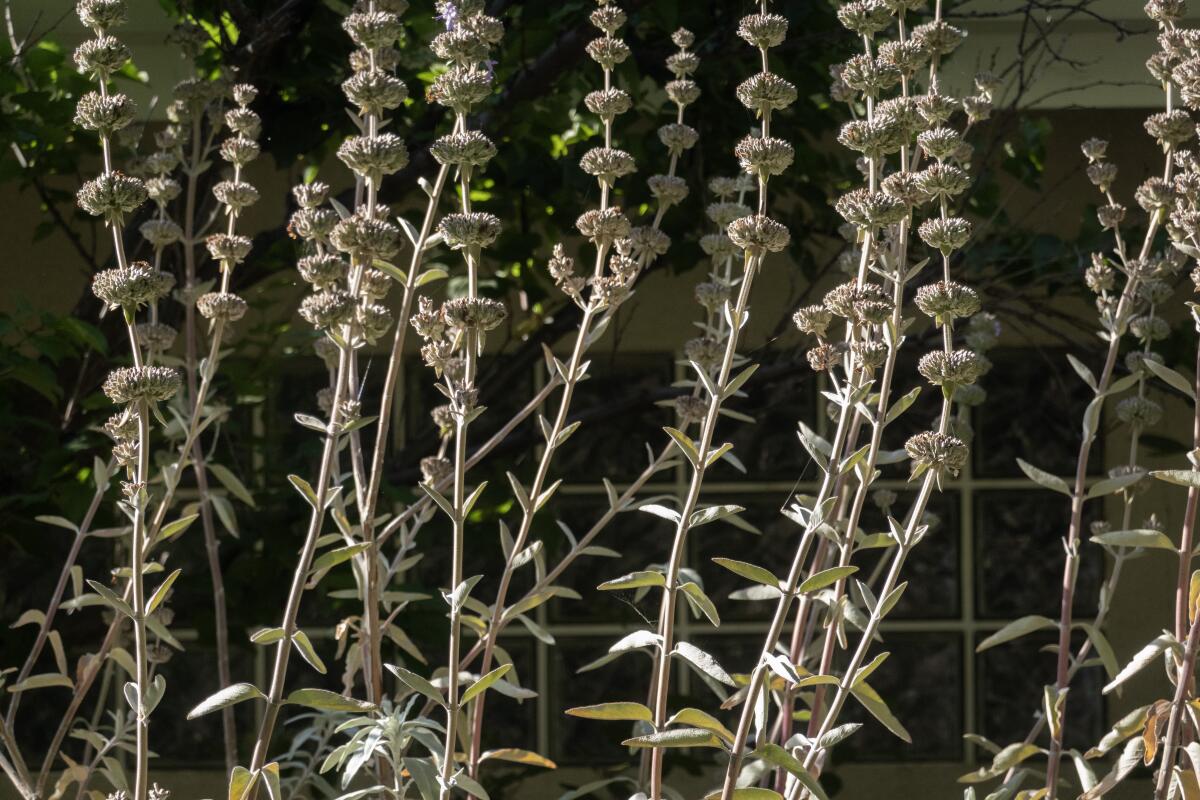
Tall gray-brown stalks of dried salvia “Desperado” blooms.
(Myung J. Chun / Los Angeles Times)
Under- and overwatering
Many native plants have adapted to Southern California’s Mediterranean climate of dry summers and wet winters, and can actually die if they’re watered too much in the summer, but they still need water when they’re first planted to get established in their new home.
Native plants have been coddled in the nursery, so they need some nurturing once they’re planted in the ground, said Tim Becker, the Theodore Payne Foundation’s director of horticulture, and the soil where you plant them makes a big difference in their water needs. For instance, clay soils hold moisture much longer than porous sandy soils, which require more frequent watering so the root ball doesn’t dry out, something that’s particularly important if the plant is in a pot.
Deep watering during planting is critical too, said Huang and Evans. Be sure to drench the root ball in its nursery pot, and fill your hole with water and let it drain completely before planting, to ensure the roots have ample moisture to adjust to their new home. Water the plant deeply again once you fill in the soil, and every week or so after, depending on the soil, so the roots don’t dry out before the rains begin.
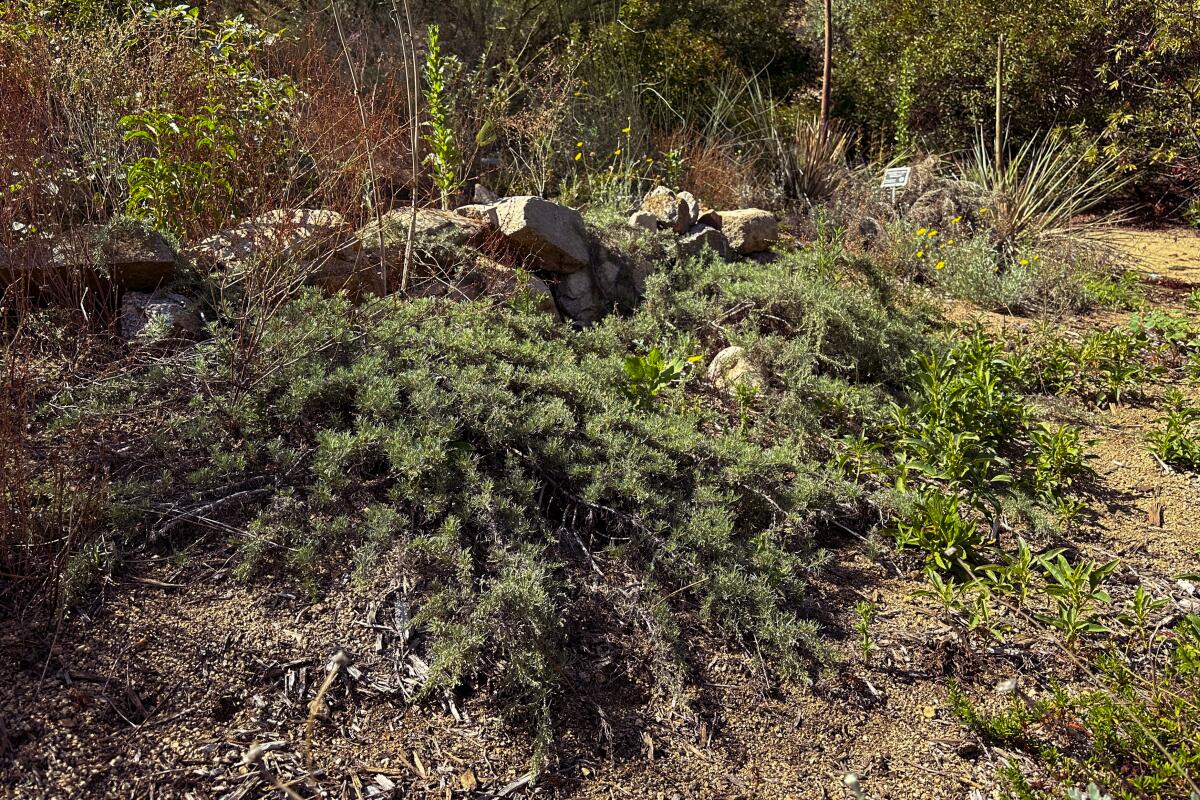
A sprawling groundcover known as canyon gray sagebrush.
(Theodore Payne Foundation)
Little diversity
A good native plant habitat has multiples — at least three — of many different plants, from wildflowers and blooming perennials to shrubs and trees, but since many native plants go dormant during the summer, it’s important that at least two-thirds of those plants are evergreens so your landscape looks good year-round, said landscape designer Parker Davis of Hardy Californians Native Plant Nursery in Sierra Madre.
Too often, people choose pretty annuals like California wildflowers and then get discouraged when those plants turn brown and ratty in the summer, Davis said. A good mix of evergreen shrubs and groundcovers can camouflage those summer dormant plants. Consider silvery white sage (Salvia apiana), canyon gray sagebrush (Artemisia californica ‘Canyon Gray’) and California buckwheat (Eriogonum fasciculatum) and the deeper greens of toyon (Heteromeles arbutifolia), lemonade berry (Rhus integrifolia) and Pigeon Point coyote brush (Baccharis pilularis ssp. pilularis ‘Pigeon Point’).
You can use Calscape’s extensive database to select what you want, such as summer bloomers or evergreens, and add your ZIP Code to get a long list of the best choices for your area.
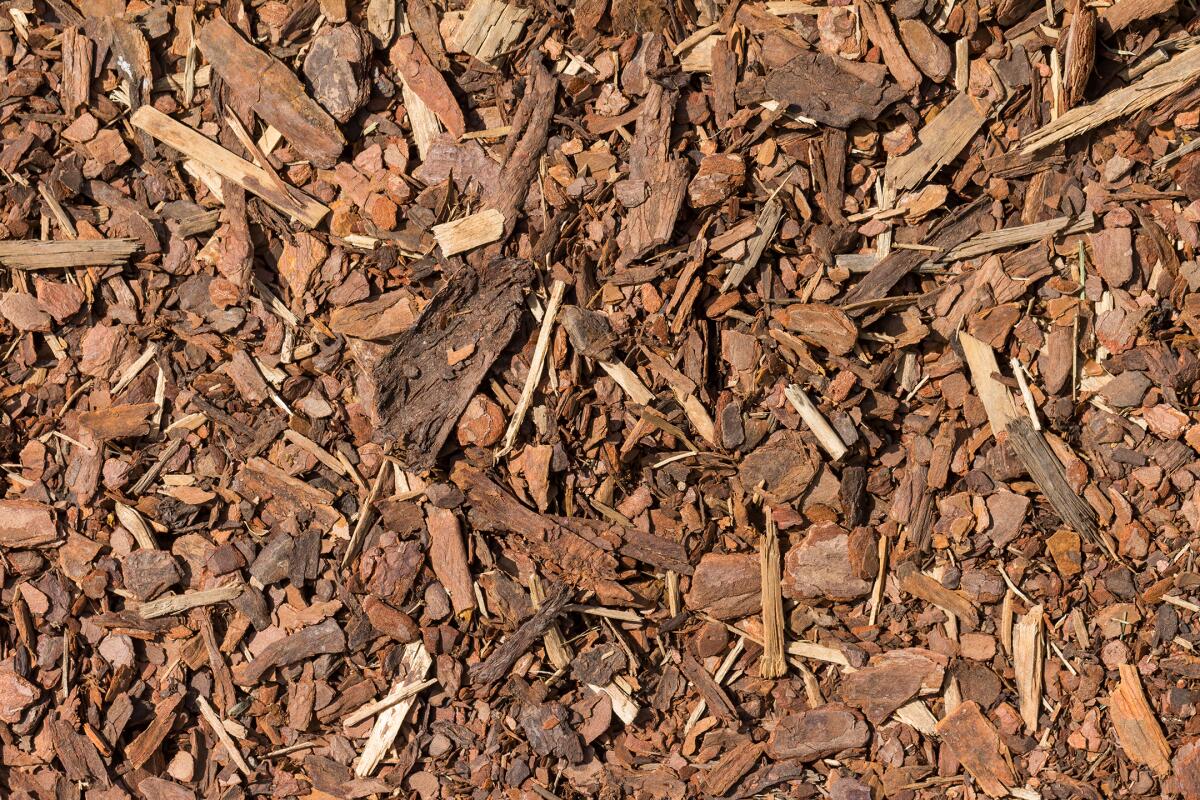
Wood chip mulch
(Roman Tsubin / Getty Images)
Weeds
Weeds are a problem with any garden, and native plant landscapes are no exception. You can mulch and eliminate unnecessary irrigation to keep them down, but you must be vigilant. I learned that lesson the hard way when I stopped adding fresh mulch to my yard. I had hardly any weeds, and figured they were gone. Then the rains came, and they reappeared with a vengeance.
Davis said that’s been one his biggest mistakes too. “If you just stick native plants in the ground, you inevitably end up with a ton of weeds, so the best step is a preventative step — laying down sheet mulch, such as cardboard with mulch on top.”
Plant densely and add thick layers of mulch to discourage weeds from getting the sun they need to sprout, and if you have patches of thick weeds, see if you can reduce the water flowing to that area (sometimes it can mean a broken drip irrigation line).
But understand that weeds are omnipresent in any garden — and that might be a good thing, because they encourage us to wander our yards and get our hands dirty by pulling them out. Researchers say regularly touching soil can extend our lives, so maybe it’s all for the best.
Newsletter
You’re reading the L.A. Times Plants newsletter
Jeanette Marantos gives you a roundup of upcoming plant-related activities and events in Southern California, along with our latest plant stories.
You may occasionally receive promotional content from the Los Angeles Times.
Upcoming events
Sept. 2
Agriculture Museum of Ventura County Ninth Annual Labor Day Tractor Fair, 11 a.m. to 2 p.m. at the museum in Santa Paula, celebrates the region’s farming and ranching history with exhibits (including old farming equipment), presentations, tours and live music. The fair opens immediately after the end of Santa Paula’s Labor Day Parade on Main Street, which starts at 10 a.m. Admission is free. venturamuseum.org
Sept. 6
Annual Ruskin Art Club Tour of Apricot Lane Farms, 9 to 11 a.m. at the Moorpark farm featured in the film “The Biggest Little Farm.” The tour is open to the public, tickets are $60 ($35 members). ruskinartclub.org
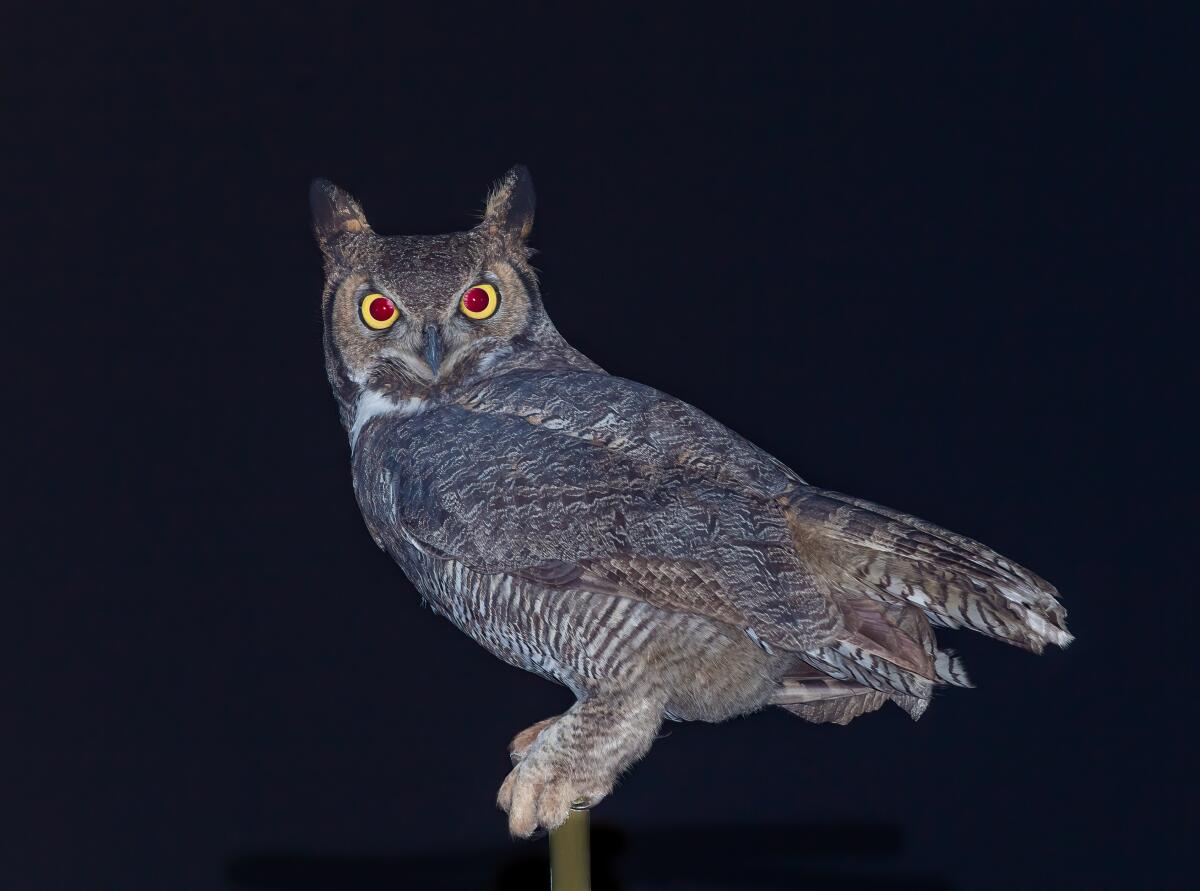
Great horned owls are dark brown with a distinctive white bib at the throat and large ear tufts.
(Ernie Cowan / For The San Diego Union-Tribune)
Sept. 6-7
Creatures: Explore Your Wild Side, a family event featuring “birds of prey, creepy crawly bugs and nocturnal animals,” as well as carnivorous plants from 5 to 7 p.m. at the Sherman Library & Gardens in Corona del Mar. Exhibitors include the Santa Ana Zoo, Adventures in Living Science and the Orange County Bird of Prey Center. Advance tickets required, $40 ($20 members, children 3 and under enter free). The Family Membership Bundle for $160 includes an annual family membership and four tickets to the event. thesherman.org
Sept. 7
Open Farm Days at Black Thumb Farm, 9 a.m. to noon at the farm in Panorama City. This free event is an introduction for teenagers, their families and educators about the Farm Hand program teaching teen volunteers how to prep, plant, maintain and harvest crops at the farm from Jan. 11 to June 21, 2025. blackthumbfarm.org
Sustainable Adobe Construction, a hands-on, step-by-step workshop taught by Ben Loescher of Loescher Meachem Architects about how to turn the dirt in your backyard into adobe bricks, noon to 4 p.m. in Pioneertown in the Morongo Basin. Register online, tickets are $145. usalproject.com
Sept. 7, 14, 21 and 28
Arboretum Nature Club, a Saturday morning camp for children ages 5-10 to participate in nature-themed activities involving science, art and cooking from 9 a.m. to noon at the Arboretum. Similar sessions are scheduled for October, November and December. Four-week sessions cost $145 per child ($135 for members). arboretum.org
Sept. 8
“Succulent Treasures of Taiwan in Habitat and Cultivation,” a talk by John Trager, curator of desert collections at the Huntington Library, Art Museum & Botanical Gardens, at the September meeting of the South Coast Cactus Succulent Society at 1 p.m. at the South Coast Botanic Garden in Rolling Hills Estates. Admission is free to club members, $15 for non-members ($11 for seniors and students with ID). southcoastcss.org
The Art & Science of Compost by Apricot Lane Farms, a three-hour composting workshop followed by an hour-long tour of the 234-acre regenerative farm in Moorpark including hot composting, worm composting and making compost tea, 8 a.m. to noon at the farm. Advance registration is required, tickets are $210.69. eventbrite.com
Sept, 10-12
Rare Seeds National Heirloom Expo from 9 a.m. to 9 p.m. each day at the Ventura County Fairgrounds in Ventura. This is the second year that Baker Creek Heirloom Seeds has held its exposition of produce displays, seeds, speakers and seed exchanges in Ventura, and based on attendance from last year, plan to arrive early and expect a crowd. Tickets are $15 a day or $30 for a three-day pass. rareseeds.com
Sept. 12
Capturing Nature’s Beauty — Smartphone Tips for Plant Lovers, a talk for the September meeting of the Southern California Horticultural Society by the society’s newest board member, photographer Marie Astrid Gonzalez, from 7 to 10 p.m. at Friendship Auditorium in Griffith Park. Admission is $5 (free to members). socalhort.org
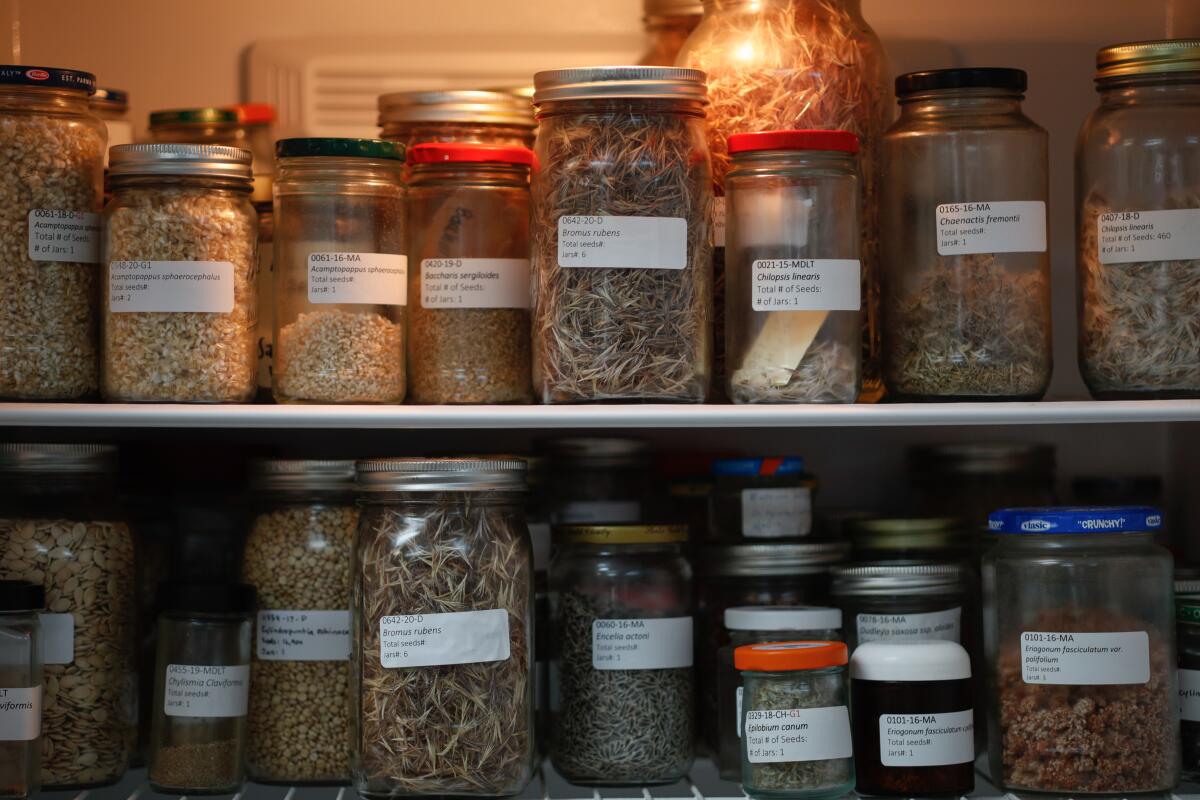
Native plant seeds are stored in a refrigerator at the Mojave Land Trust.
(Gina Ferazzi / Los Angeles Times)
Sept. 13
“The Mojave Desert Seed Bank: Supporting a diverse ecosystem into the future,” is a free talk by Mojave Desert Land Trust’s Seed Program Manager Patrick Emblidge from 6 to 7 p.m. at the land trust headquarters in Joshua Tree. Reservations are recommended. eventbrite.com
Sept. 14
Tinyplants Succulent Driftwood Workshop, a class in creating succulent driftwood arrangements, 2:30 to 4:30 p.m. at The Oaks in Thousand Oaks. Tickets are $12.51, and the proceeds will benefit the Turning Point Foundation’s Growing Works employment program for people with behavioral health diagnoses. eventbrite.com
Sept. 14-Jan. 6
“Growing and Knowing in the Gardens of China,” a new exhibition at The Huntington Library, Art Museum and Botanical Gardens’ Chinese Garden in San Marino, shows how China’s Ming (1368-1644) and Qing (1644-1921) dynasties used gardens to “not only delight the senses and nourish the body, but also inspire the mind — both intellectually and spiritually,” according to the website. The exhibit includes books, paintings and reproductions of gardening tools, as well as a garden of blooming hybrid chrysanthemums developed by Chinese scholars and gardeners. The exhibit is free with $29 admission to the Huntington ($24 for seniors 65+, military and students with ID; $13 ages 4-11, free to members and children under 4). huntington.org
Sept. 16
Bilingual Docent Tour of the Santa Barbara Botanic Garden in celebration of Latino Conservation Week, a free tour of the state’s second largest native plant botanic garden from 10 to 11 a.m. Advance registration is required. sbbotanicgarden.org
Sept. 18
Mojave Desert Land Trust field monitoring and first aid training for volunteers, 9 a.m. to 4 p.m. in Joshua Tree, including a free first aid/CPR certification, wilderness first aid training, a topographic map workshop, monitoring software, protocol, and naturalist training. Advance registration is required. mdlt.org
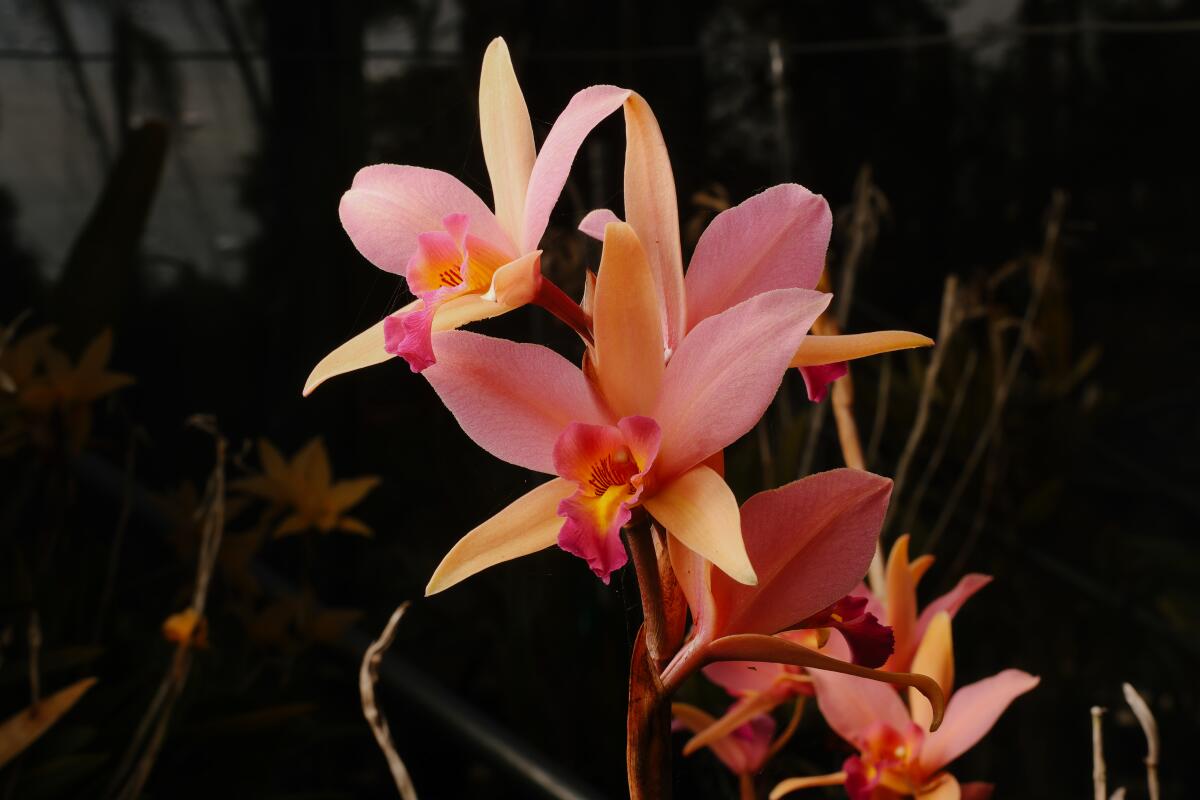
A Santa Barbara Sunset orchid developed by Paul Gripp of the Santa Barbara Orchid Estate.
(Dania Maxwell / Los Angeles Times)
Sept. 20-22
43rd Fascination of Orchids International Festival of Orchids & Exotic Plants, 10 a.m to 4 p.m. at the Santa Ana Zoo in Santa Ana. Free with $13 admission to the zoo ($10 ages 3-12 or ages 60+, free for ages 2 and under.) santaanazoo.org
Sept. 20
Intro to California Native Plant Garden Design with Tim Becker, horticulture director for the Theodore Payne Foundation. The class will cover the basics of designing a home or community garden, considering topics such as light, irrigation and space. Tickets are $60.54 ($55.20 for members). eventbrite.com
Sept. 21
Native Plant Water Gardening in Containers, a Theodore Payne Foundation workshop taught by horticulturist Andrew Chaves, 9 to 11 a.m. at the foundation in Sun Valley. Tickets are $40 ($30 members). eventbrite.com
Shakespeare in the Garden, a workshop exploring William Shakespeare’s use of plants as metaphors taught by Albert Garnica, the foundation’s education manager, from 3 to 5 p.m. at the Theodore Payne Foundation in Sun Valley. Participants are encouraged to bring their own food and beverages for a picnic. Tickets are $39.19 ($28.52 for members, children 12 and under free). eventbrite.com
Santa Barbara Botanic Garden Native Plant Bike Tour, as part of Latino Conservation Week, a free guided 6.5-mile ride through downtown Santa Barbara with stops to point out key native California plants along the way, at 2 p.m. sbbotanicgarden.org
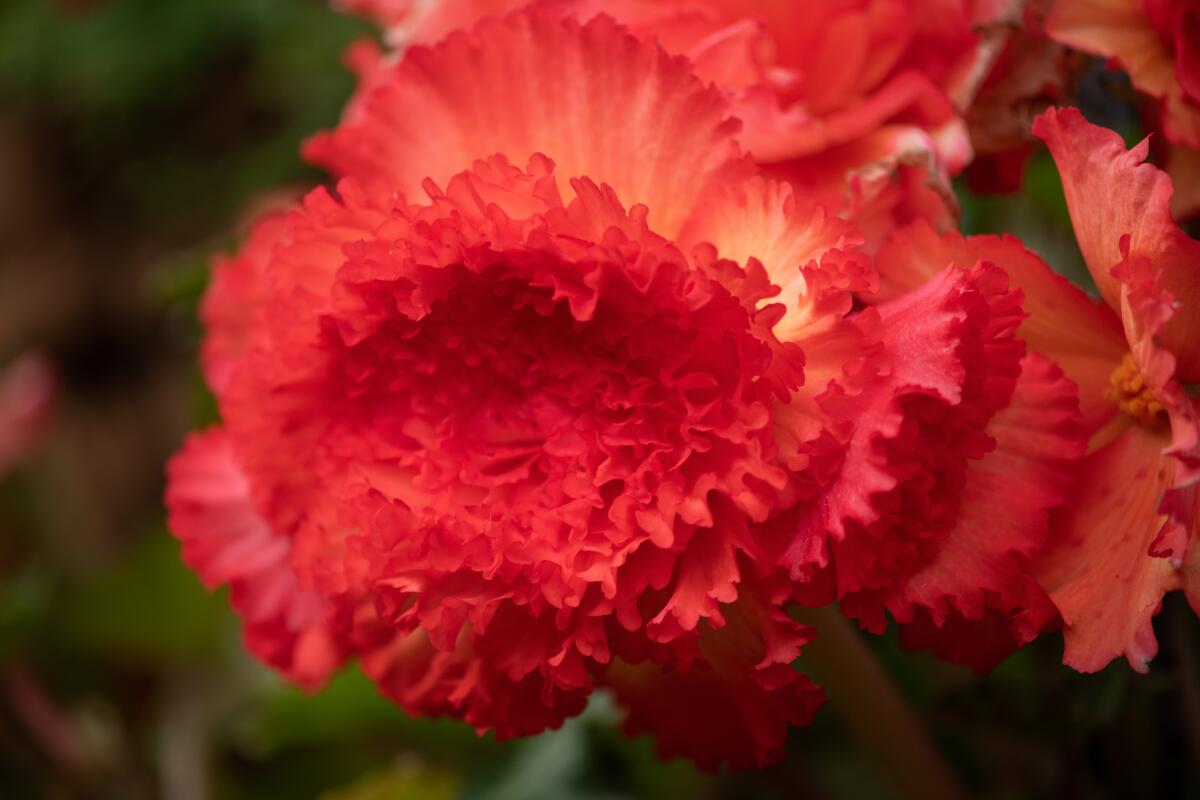
A deep salmon-colored tuberous begonia from the garden of famed actress and dancer, Julie Newmar.
(Mariah Tauger / Los Angeles Times)
Sept. 21-22
Southern California Begonia Society Begonia Show & Sale, 10:30 a.m. to 4 p.m. at the Sherman Library & Gardens in Corona del Mar. The show includes talks at 11:30 a.m. each day about growing begonias in terrariums (Sept. 21) and begonia growing and care (Sept. 22) and a guided tour of the gardens’ begonia collection at 1:30 p.m. on Sept. 22. The show is free with $5 admission to the gardens (members and children 3 and younger enter free). thesherman.org
Sept. 25-Dec. 11
UCLA Extension Horticultural Pest Management course taught by Douglas Kent, an 11-week course covering the identification and management of common garden insects, diseases and weeds common in California. The course is $670. uclaextension.edu
Sept. 26
Irrigation Basics for Native Plants, a walk and talk with Theodore Payne Foundation educator Erik Blank, 9:30 to 11 a.m. at the foundation garden in Sun Valley. Tickets are $23.18 ($17.85 for members). eventbrite.com
Sept. 28
Creating a Sustainable Home, a Theodore Payne Foundation workshop taught by biologist Jessica Ullyott, will cover recycling, power purchasing, waste reduction, gardening and landscaping, 10 a.m. to noon at the foundation in Sun Valley. Tickets are $39.19 ($17.85 ages 13-18, $28.52 for members). eventbrite.com
Consider subscribing to the Los Angeles Times
Your support helps us deliver the news that matters most. Become a subscriber.
What we’re reading
I had a bit of a rant in August when I argued that L.A. is too ugly now to host the Olympics, but there are things we can do to make it better. Spoiler alert: This is a great opportunity to celebrate our history while beautifying our bleak concrete corridors and boring lawns with native trees and containers of fragrant native shrubs. But that’s just the beginning.
My colleague Lila Seidman captured a good example of one spontaneous beautification effort when two friends tired of a smelly, trashy parkway and created their own little urban oasis in East Hollywood.
For more than a decade, the Children’s Garden at Elysian Park was a shady showcase for indigenous plants, visitors say, with dense stands of mature native trees and shrubs creating cool, restful places to walk, play and learn. And then a contractor hired by the city’s Department of Recreation and Parks cut out almost all the native plants in the garden for fire prevention and created a firestorm.
